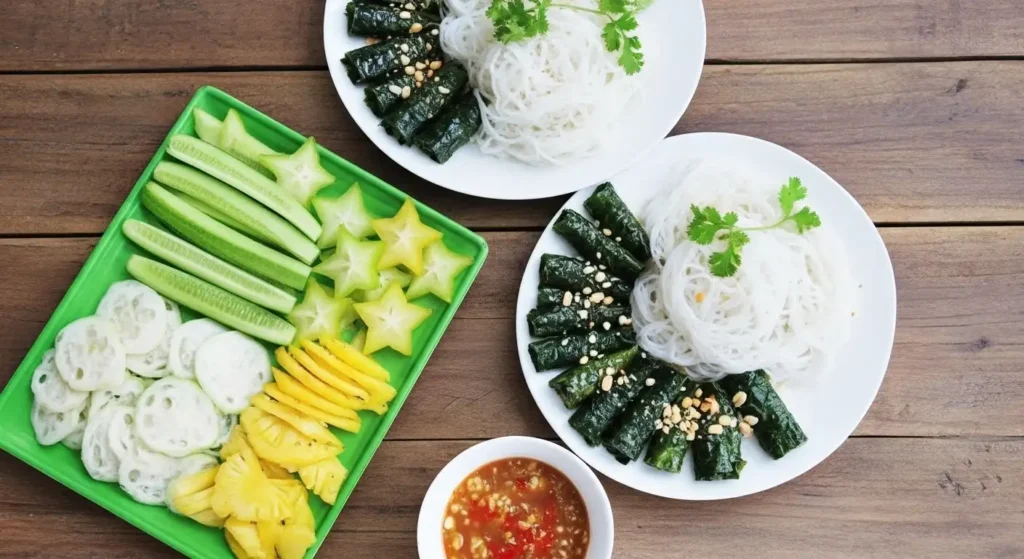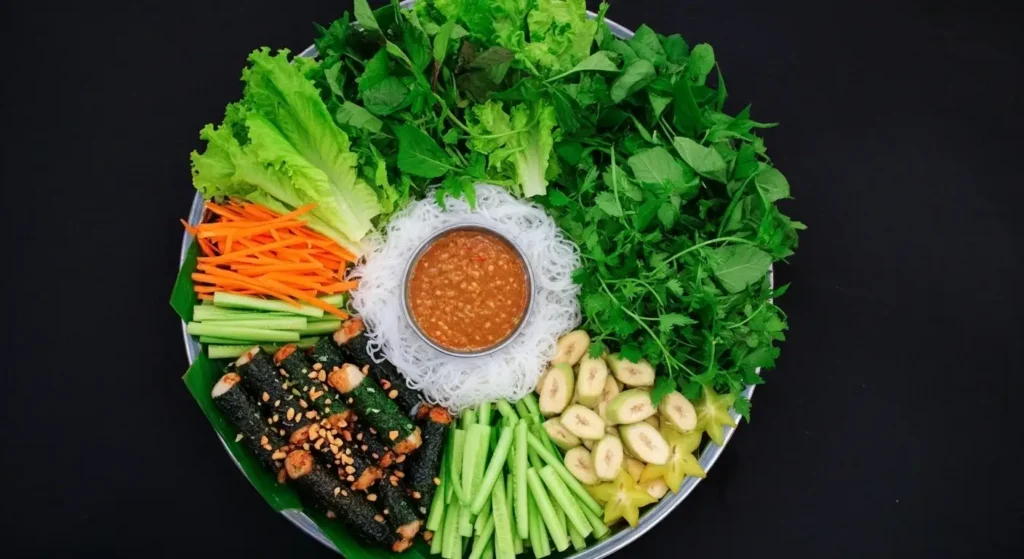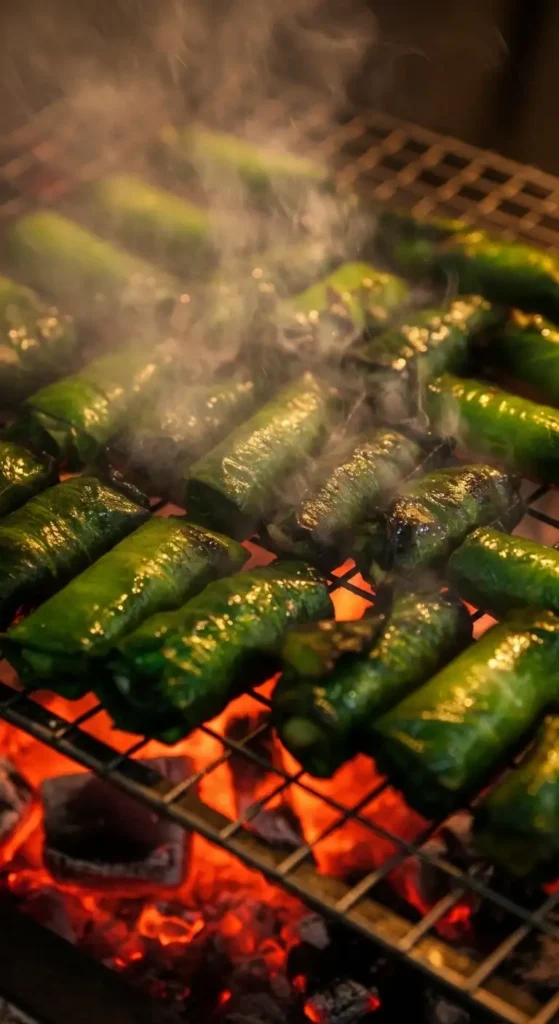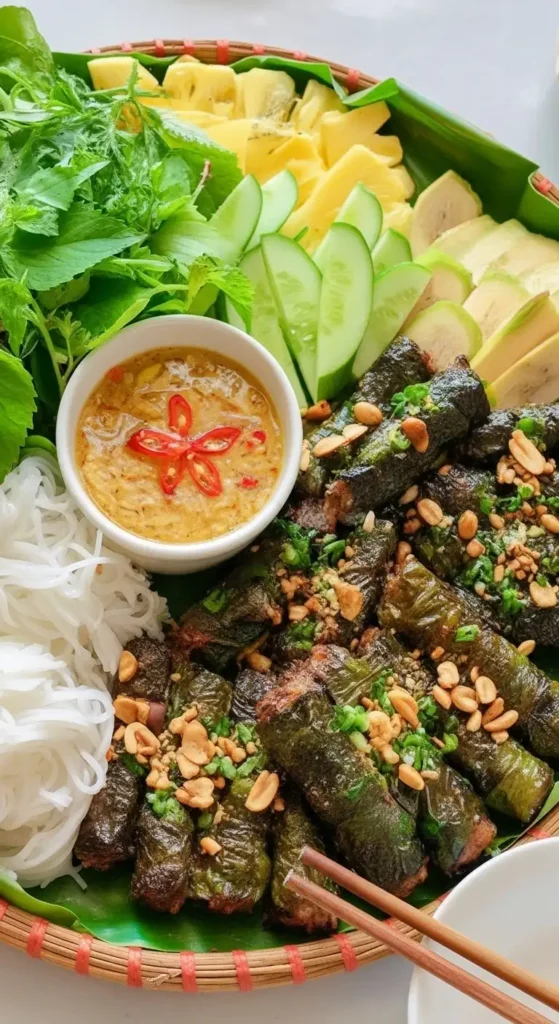Bò Lá Lốt (pronounced roughly Baw La Lot) is one of the most beloved street foods in Vietnam, celebrated for its unique, intoxicating aroma and rich, savory flavor. The name itself translates simply to “Beef in Lá Lốt Leaf,” referring to the signature preparation where seasoned ground beef is wrapped in a wild betel leaf (Lá Lốt or Piper Sarmentosum) and grilled over hot charcoal.
This dish is a testament to the Vietnamese genius for pairing simple, earthy ingredients with bold, aromatic spices, resulting in a complex and satisfying culinary experience.

Bò Lá Lốt: The Basics
The Star Ingredient: Lá Lốt: The key to this dish is the Lá Lốt leaf, often mistaken for the true betel leaf (Lá Trầu), which is used for chewing. Lá Lốt is a heart-shaped leaf with a shiny, dark green surface and a distinctive, slightly peppery, and medicinal flavor. When grilled, the leaf releases an intense, smoky, and herbaceous fragrance that is instantly recognizable on the streets of Vietnam.
The Meat Filling (Thịt Bò): The filling is typically a savory mixture of ground beef (often mixed with fatty ground pork or pork fat to ensure juiciness), seasoned heavily with Vietnamese aromatics:
Sả (Lemongrass)
Hành Tím (Shallots)
Tỏi (Garlic)
Nước Mắm (Fish Sauce)
A dash of Curry Powder or Five-Spice Powder is often added for depth.
The Cooking Method: The small, tightly rolled parcels are traditionally placed on a grill basket and cooked over open charcoal (nướng). The grilling process simultaneously cooks the beef and toasts the Lá Lốt leaf, crisping the exterior and allowing the beef juices to infuse with the leaf’s unique fragrance.
Serving and Varieties
While Bò Lá Lốt is a dish in itself, it is frequently served as part of a larger Vietnamese meal concept, particularly in the South.
The Standard Plate: Finished rolls are typically brushed with scallion oil (Mỡ Hành) and garnished with crushed roasted peanuts (Đậu Phộng). They are served alongside a platter of fresh herbs, thin rice vermicelli noodles (Bún), and sometimes soft rice paper wrappers (Bánh Tráng).
Variety of the Roll: While beef is standard, the core concept of meat wrapped in a leaf appears in other dishes:
Bò Mỡ Chài: Grilled beef wrapped in caul fat (a fatty membrane), often served alongside Bò Lá Lốt for a contrasting richness.
The Dipping Sauce: The dipping sauce is critical. The two most common choices are:
Nước Mắm Pha: The classic sweet and sour fish sauce dip.
Mắm Nêm: A strong, savory, and pungent fermented anchovy sauce, often mixed with chili, pineapple, and sugar. This bolder sauce is often preferred in the South to complement the rich grilled meat.
Bò Bảy Món (Seven Courses of Beef): In the South, Bò Lá Lốt is often featured as one course within the elaborate Seven Courses of Beef meal, showcasing the versatility of beef in Vietnamese cuisine.

How to Eat Bò Lá Lốt
Eating Bò Lá Lốt is an interactive, do-it-yourself rolling ritual. It’s the combination of the hot, smoky roll with the cool, fresh herbs and crunchy garnishes that makes the dish exceptional.
Gather Your Tools: Ensure you have a stack of herbs (lettuce, mint, coriander), a bowl of Bún (vermicelli), and the dipping sauce. If rice paper is provided, you will need a small bowl of water to quickly moisten it.
Assemble the Roll (If using Rice Paper):
Dip a sheet of rice paper quickly into the water to soften it slightly.
Place a large lettuce leaf and a handful of fresh herbs (like mint, perilla, and basil) on the rice paper.
Add a generous portion of Bún noodles.
Place one or two of the hot Bò Lá Lốt rolls on top.
Roll and Dip: Roll the ingredients up tightly like a spring roll. Dip the entire roll into your preferred sauce (Nước Mắm Pha or Mắm Nêm) and enjoy the immediate explosion of hot, smoky beef, cool, crisp herbs, soft noodles, and savory sauce.
Simpler Method: If skipping the rice paper, simply take a piece of the Bò Lá Lốt, place it inside a large lettuce leaf with some herbs and noodles, and eat it like a lettuce cup before dipping.
Regional Differences
Bò Lá Lốt is recognized across Vietnam, but it is unequivocally a Southern Vietnamese specialty in its preparation and prominence.
| Region | Primary Focus and Popularity | Key Differences in Preparation/Serving |
|---|---|---|
| South (Miền Nam - Saigon) | Supreme Popularity. Bò Lá Lốt is readily available on every street corner and is central to the nhậu (social dining) scene. It is often served as a main dish or part of the Bò Bảy Món. | The rolls are typically juicier and fattier, often mixing beef with pork fat. The essential accompaniment is the robust and intense Mắm Nêm (fermented anchovy sauce), reflecting the Southern taste for bold, powerful flavors. |
| Central (Miền Trung - Huế, Đà Nẵng) | Present but Less Central. The leaf (Lá Lốt) is used in Central cuisine, but the grilled beef roll is less ubiquitous than in the South. Central cuisine focuses more on intensely spicy, royal-inspired dishes. | When served, it is often paired with the Central style of Nước Mắm Pha (dipping sauce), which tends to be spicier and more balanced than the sweet Southern style, yet less pungent than Mắm Nêm. |
| North (Miền Bắc - Hanoi) | Least Common. While the Lá Lốt leaf is known, the grilling technique and the specific dish are not a traditional part of the Hanoi culinary scene, which focuses more on soups (Phở, Bún Ốc) and grilled pork (Bún Chả). | Where it is found, it is generally served with a simpler, classic Nước Chấm (lime-based fish sauce), avoiding the intense flavors of Mắm Nêm which are less common in the more subtle Northern palate. |




